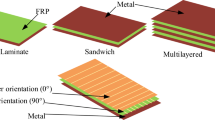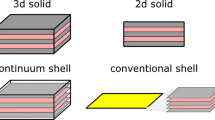Abstract
Fibre Metal Laminates (FML) represent a family of hybrid materials, consisting of alternating layers of thin metal sheets and fibre reinforced epoxies. The concept, invented in the late 1970s, has resulted in laminates like ARALL and GLARE. The first material is made of aluminum alloys, aramid fibres and an epoxy resin, GLARE laminates use similar constituents except for the aramid fibres, which are replaced by glass fibres. Besides, a specific laminate is determined by its layer thickness, fibre orientation, number of layers, etc., parameters, which can be regarded as variables. The first large scale application of the GLARE laminates is the fuselage of the Airbus A-380 aircraft. Large sections of the fuselage, both in the front and aft section will have a GLARE skin and some local GLARE doublers. Before this material could be applied to the A-380, it took more than 20 years of research and development, and the R&D is still continuing. The research that is performed is a mixture between testing and modeling: testing is necessary for the optimization of the laminates, and a lot of test evidence is required for certification and qualification purposes. In addition also analytical and numerical tools have been developed to limit the number of tests, to determine design allowables, and to predict the material behavior in a multitude of structural applications and details. Current and future research on FML has at least two objectives. On one hand the research is focused on generating new laminates based on the same concept, on the other hand the modeling is advancing in order to improve existing models and to develop new ones (tools for the analysis of structures). The tendency for the modeling is from macro-scale towards meso- and even micro-scale modeling. From the modeling and experimental point of view these hybrid materials, mixtures of metal and composite layers, offer specific challenges. Since fibres are embedded in the matrix and the materials have a layered structure, typical composite characteristics and failure modes are involved like anisotropy, fibre–matrix interfaces, matrix cracking, and delamination. On the other hand due to the metal constituents the laminates show plastic behavior and have discrete interfaces between the metal and the resin. In this paper an overview is presented of the research and development of FML, in particular the development of GLARE. The emphasis in this overview will be on the understanding and analysis of these laminates, and the development of appropriate tools (models). Over the years the development was a concurrent one: both testing and modeling were performed simultaneously. Special attention will be paid on the current and future research that is planned for a further understanding of this structural material. This research is dominated by numerical calculations and simulations and is aiming for topics like the prediction of the fracture energy, the crack bridging effect, and the blunt notch behavior of laminates.














Similar content being viewed by others
References
Vlot A, Glare (2001) History of the development of a new aircraft material. Kluwer Academic Publishers, The Netherlands
Alderliesten RC (1998) Development of an empirical crack growth model for Fibre Metal Laminates. Preliminary MSc Thesis, Delft University of Technology
Vermeulen B, van Tooren MJL, Peeters LJB (September 2005) Knowledge-based design method for fibre metal laminate fuselage panels. Int DETC conference, Long Beach, CA, USA
Alderliesten RC (2005) Fatigue crack propagation and delamination growth in glare. PhD Thesis, The Netherlands
Suiker ASJ, Fleck NA (2004) J Fatigue 125:1
de Jong TJ (2004) Forming of Laminates. PhD Thesis, The Netherlands
Hagenbeek M (2005) Characterization of FML under thermo-mechanical loadings. PhD thesis, The Netherlands
van Rooijen RGJ (2006) Bearing strength characteristics of standard and steel reinforced GLARE, PhD thesis, The Netherlands
Roebroeks GHJJ (2000) The metal volume fraction approach, TD-R-00-003. SLI, Delft
DIALFAST (2004) Development of innovative and advanced laminates for future aircraft structures. CEC 6th Framework Program, Specific, Targeted, Research Project, No. 502846
Middendorf P, Linde P, de Boer H, Sinke J (2005) Micro-mechanical modelling approach for Fibre Metal Laminates. NAFEMS Conference
Author information
Authors and Affiliations
Corresponding author
Rights and permissions
About this article
Cite this article
Sinke, J. Development of Fibre Metal Laminates: concurrent multi-scale modeling and testing . J Mater Sci 41, 6777–6788 (2006). https://doi.org/10.1007/s10853-006-0206-5
Published:
Issue Date:
DOI: https://doi.org/10.1007/s10853-006-0206-5




